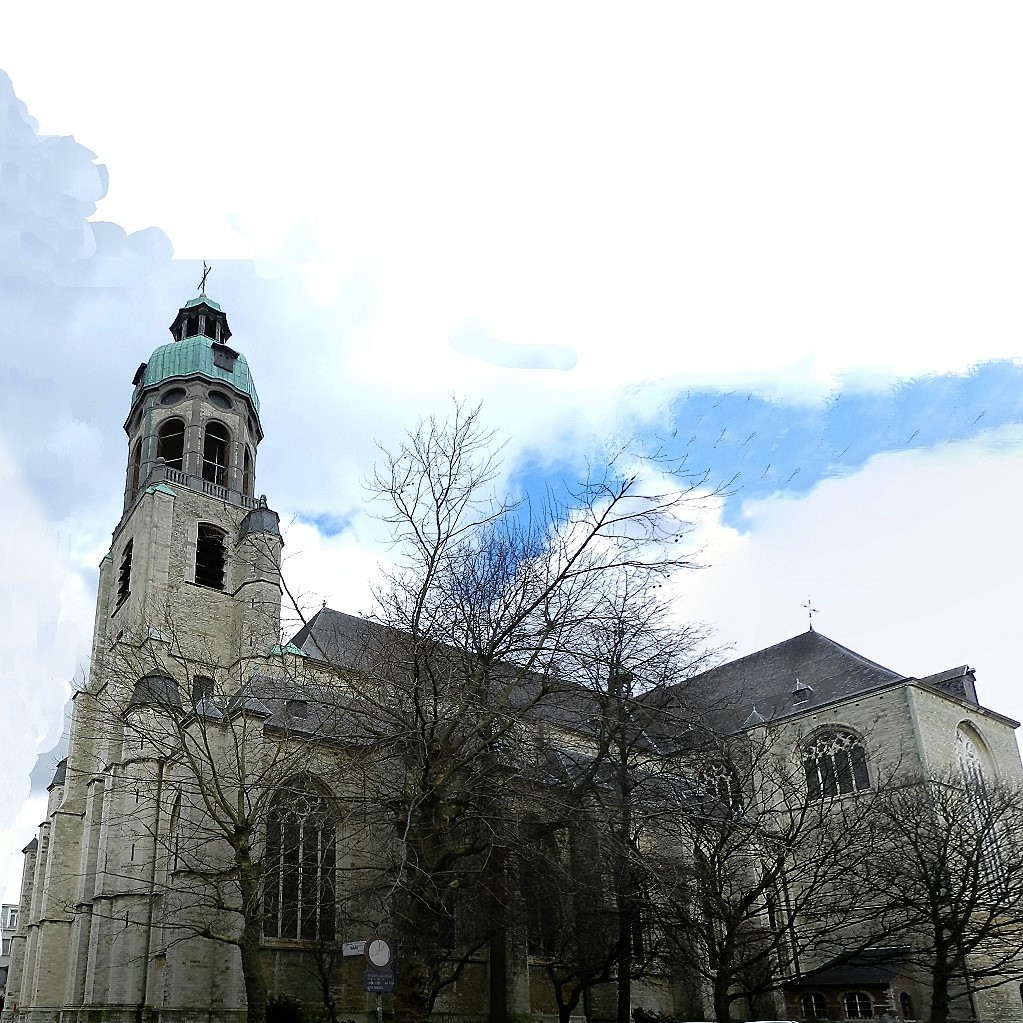Antwerp's St Andrew's Church, a revelation.
Saint Andrew in art: iconography
| Male person: | rectangular face, advanced age: ‘manful’ full grey beard, long sharp nose, and piercing eyes. |
| From antiquity: | often dressed in a long tunic and a cloak. |
| SaintThis is a title that the Church bestows on a deceased person who has lived a particularly righteous and faithful life. In the Roman Catholic and Orthodox Church, saints may be venerated (not worshipped). Several saints are also martyrs.: | a halo symbolises the divine light of love and wisdom radiating from the saint. |
| Disciple: | · a book of the gospelOne of the four books of the Bible that focus on Jesus’s actions and sayings, his death and resurrection. The four evangelists are Matthew, Mark, Luke, and John. ‘Gospel’ is the Old English translation of the Greek evangeleon, which literally means ‘Good News’. This term refers to the core message of these books., open or closed. Christ, ‘the Word of God’, formed the source of inspiration of his life, and he proclaimed his belief in Christ on his missionary travels. · scroll with inscription: on the Apostolic CouncilA large meeting of ecclesiastical office holders, mainly bishops, presided by the pope, to make decisions concerning faith, church customs, etc. A council is usually named after the place where it was held. Examples: the Council of Trent [1645-1653] and the Second Vatican Council [1962-1965], which is also the last council for the time being. in Jerusalem in 44, each disciple supposedly expressed one of the creed’s twelve Articles of Faith. Andrew formulated the fourth article: “who was crucified under Pontius Pilate, suffered, died, and was buried”. · barefoot: “Carry no purse, no bag, no sandals; and salute no one on the road” (Lk 10:4), “How beautiful are the feet of those who preach good news!” (Rom 10:15), saying based on Isaiah (52:7). |
| Fisherman: | fishing attributes, such as nets, fish, a little boat, and a shell. |
| BishopPriest in charge of a diocese. See also ‘archbishop’. of Patras and of Constantinople | especially during the Baroque era, one would have expected to see any disciple accompanied by bishop’s insignia, such as a mitreThe ceremonial headgear of bishops and abbots. The front and back are identical pentagons pointing upwards., a crosier, a pectoral cross and a cope. Depictions of Andrew were exceptional in this regard; moreover, the bishopric of Andrew, which was in the Orthodox areas, was not well-known. |
| MartyrSomeone who refused to renounce his/her faith and was therefore killed. Many martyrs are also saints.: | · crucifixion: bound to a cross, not nailed. · from the end of the 12th century onwards, this cross was given the special shape of a crux decussata (Lat. ‘decussis’: decem (10, in Latin characters: X) + ‘axis’: division by use of an X-cross). Later on, this cross became known as St. Andrew’s Cross or saltire. · Often constructed out of unplaned trunks, a cross in this shape thus became seen as the quintessential instrument of Andrew’s martyrdom, as Patras lore would have it. This tradition became more widespread during the 14th century and dominated during the 15th century. This was partly due to the influence of the Burgundy dynasty and the Order of the Golden Fleece: hence, the shape was also called ‘the Cross of Burgundy’. Influenced by the West, the St. Andrew’s Cross was later introduced in the Orthodox church; also in Patras! · Andrew hugs the cross, thus showing how he doesn’t shy away from martyrdom. · a palm branch. Sacrificing his own life for his faith, the martyr was given a joyous entry into heavenly Jerusalem: although he did lose out by dying, he was given heavenly victory in the end. |
| Miracle worker: | balsam. The saint’s body would have escaped disintegration and had a fragrant scent, see the relicA remnant of the body of a saint or a (part of) an object that has been in contact with a saint, Jesus, or Mary. The very first sanctuaries were built on graves of saints. Remnants of these saints were distributed to other churches and chapels. The first altars were usually the sarcophagi of the saints. Hence the custom of placing relics under the altar stone. Relics are also kept in shrines, and sometimes displayed in reliquaries. shrineA decorated casket in which a relic is preserved. ‘Boat of Amalfi’ (p.152). |
| Patron of: | Greece, Scotland, Russia and of the Order of the Golden Fleece, which has sported the St. Andrew’s Cross as armorial bearing. |

